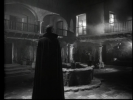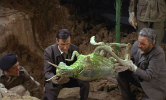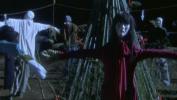Reviews
Roy Ward Baker
UK, 1967
Credits
Review by Glenn Heath Jr.
Posted on 09 October 2011
Source Anchor Bay DVD
Categories 31 Days of Horror VIII
Cold war paranoia, telekinetic torture, and apocalyptic riots—Roy Ward Baker’s batshit Quatermass and the Pit has it all, positing the pervasiveness of man-made fear as the root of modern evil. Our crippling tendency to deceive and destroy each other is framed as instinctual, an original trait with which all human beings are born. Yet Quatermass and the Pit takes this thesis one step further, contemplating the possibility we owe all cognitive thought, the good, the bad, and the ugly of modern humanity, to a Martian life-form that crash landed millions of years previous. In an attempt to salvage their own dying civilization, the grasshopper-like insects instilled humans with complex cerebral functions such as second sight and mind control, building a proxy community of sorts that in turn passed on these potentially amazing traits to further generations.
Set knee-deep in the swinging 1960’s of London, Quatermass and the Pit functions as a kind of time capsule for Mod color schemes and social distrust, a tipping point between old English hierarchies and post-modern unease. Like many horror films of its ilk, Quatermass and the Pit opens with a sudden disruption of the rational world. During a redevelopment project, a strange craft is discovered hidden underneath a dilapidated tube station, covered in layers of clay and strange skeletal remains. Almost immediately, scientists and military personnel flood the area, attempting to classify what cannot be rationalized and bring order to this sudden break in normalcy. Professor Quatermass, an expert on jet propulsion, is brought in when initial reports peg the unknown craft as an unexploded German rocket left over from WWII.
If Quatermass and his flare for objectivity come to represent flexible human thought, his military counterpart, a smug officer named Colonel Breene, reflects man’s worst impulses. The two often square off, shooting rhetoric and political jargon back and forth and thus miring the film in anecdotal dialogue sequences that all but squashes the film’s momentum. Quatermass and the Pit tends to avoid traditional horror pacing (increasing danger, escalating tension), favoring instead long, ominous debates about man’s purpose and fate. Fittingly, it emphasizes the spread of information within a given social construct, the way words maim all potential for peace. Rumors, slander, media coverage, and governmental repression all play a role in defining the distrusting social milieu of Quatermass and the Pit, unseen layers of human (mis)communication that parallels motifs of physical and instinctual burial. One theme remains true throughout: dig deep enough and you’ll find the devil.
This process is often strenuous, taking the gripping possibility of genre and turning it into a pedantic blame game where the higher classes thumb their noses at each other. Still, by addressing the pervasiveness of social distrust and malcontent with such a deathly serious tone, Quatermass and the Pit can only be taken as satire. There are darkly comedic roots beneath the wooden surface, bits of irony appearing in the form of carefully placed societal markers. After a cheesy opening credit sequence shows a skull being quickly assembled like pieces of an ancient puzzle, Baker smoothly dollies down a drab back-end London road, finally centering on the aforementioned redevelopment site. Immediately before descending into the titular pit where all hell is about to break loose, Baker’s excitingly fluid camera captures a telling sign in the background. “Apologises to passengers for any inconvenience.” Considering the film’s lengthy and ludicrous climax that finds most of London’s citizens possessed by their Martian instincts to kill, kill, kill, this missive is nothing if not deftly hilarious.
Ultimately, the battle between scientific reason and military aggression defines the surface of Quatermass and the Pit. Beyond this familiar tension lies a disturbing reality: both are futile, hopeless rationales when pressed to define unexplainable phenomena. It’s the constant arguments between the two sects, the film’s unrelenting concern with each character’s verbal diarrhea, that makes the more outlandish science fiction sequences take on a horrific quality. Amazingly, in the final moments when the flickering space ship becomes self aware, nasty varicose veins running down its surface mass, Quatermass and his assistant Barbara are finally left speechless. Seconds later, the entire dig site is turned into a swirling wind tunnel of flying debris and loud vibrations, a kind of requiem for the spoken word.
By the end of Quatermass and the Pit, London is torn apart by its own inhabitants, a raging band of human insects destroying anything and anyone slightly different than themselves. It’s a pretty blatant metaphor for the cost of nuclear threat, something Baker clings to despite his film’s astoundingly delusional narrative points. As the final credits roll, Quatermass and Barbara sit together breathing heavily, unable to look at each other despite the mass chaos around them. Their plight, once defined by the image of the space ship and alien insects, is now an internal one. If Quatermass and the Pit isn’t especially convincing as a traditional monster movie, it does leave one with a feeling of horror more than anything else, a notion that no matter the political or scientific spectrums controlling the world, we’re all damned anyway. Self-destruction is a genetic trait.
More 31 Days of Horror VIII
-

Westworld
1973 -

Child’s Play
1988 -

Jacob’s Ladder
1990 -

Willy Wonka and the Chocolate Factory
1971 -

El Vampiro
1957 -

28 Weeks Later
2007 -

Piranha II: The Spawning
1981 -

The Others
2001 -

Quatermass and the Pit
1967 -

I Know Who Killed Me
2007 -

Bride of Re-Animator
1990 -

Alucarda
1978 -

Kakashi
2001 -

Seizure
1974 -

Night of the Living Dead
1968 -

Night of the Living Dead
1990 -

The Bat Whispers
1930 -

Miracle Mile
1988 -

Tintorera
1977 -

Paradise Lost
1996 -

The Cars that Ate Paris
1974 -

Ginger Snaps
2000 -

J.D.’s Revenge
1976 -

The Wicker Man
2006 -

Black Water
2007 -

Don’t Panic
1988 -

The Driller Killer
1979 -

Targets
1968 -

Mahal
1949 -

Event Horizon
1997
We don’t do comments anymore, but you may contact us here or find us on Twitter or Facebook.



